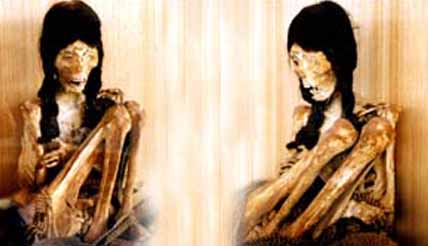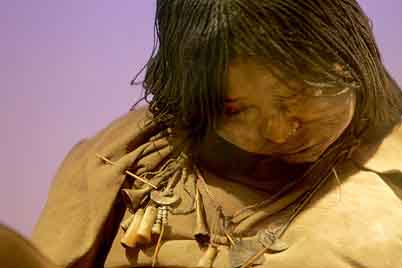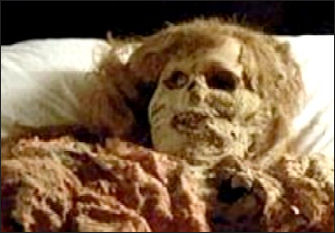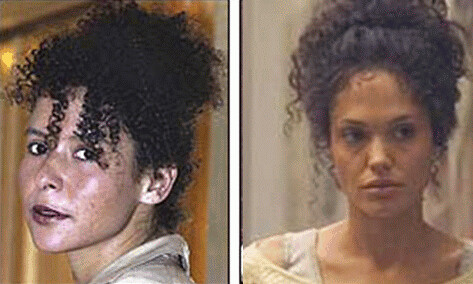

Go back to 5000 bc
White skin mummies of china; eurocentrics claim its white, asians say it asian, in reality its unclear, because early central asian from northern china, mongolia and kazakstan formed a eurasian type peoples whose race can be difficult to decipher.

This is what a white blonde hair and probably blue eyed or near white mummy looks like. It doesn't magically transform to black after dying. It doesn't get neon blonde hair. Its hair doesn't become perffectly aligned curls, it actually becomes quiet bushy looking. White hair if uncombed will look like this, it usually will not stay straight.
Tarim mummy probably closer to the asian looking side

Italian child mummy from last 500 years

why did she not turn black like the white egyptian mummy, white chinese mummy and white chilean mummy I demand answers?
So what exactly is the fraud, well the mummies themselves are not likely fraud, the fraud here is the claim. the claim that clearly black skinned people, black skinned mummies were white, when we have hundreds of examples of true white skinned mummies, who retain their white skin
If euroclowns want me to believe black skinned mummies like this are white

Then what of the above actual white mummies, were they transparent or ghost?
finally one might ask where is the evidence to support these claims of hair changing. You asked, you got it. Studies have shown that not only everything I stated about the hair was correct (the straightening part) but when white europeans went to test the hair to determine the race they found it to be "more negroid than anything around today".
This article which can be found online brings together the various resources, so I quote from it, but you can read it to.
Quote:
| The cross-section of a hair shaft is measured with an instrument called a trichometer. From this you can get measurements for the minimum and maximum diameter of a hair The minimum measurement is then divided by the maximum and then multiplied by a hundred. This produces an index. A survey of the scientific literature produces the following breakdown: San, Southern African 55.00 Zulu, Southern African 55.00 Sub-Saharan Africa 60.00 Tasmanian (Black) 64.70 Australian (Black) 68.00 Western European 71.20 Asian Indian 73.00 Navajo American 77.00 Chinese 82.60 In the early 1970s, the Czech anthropologist Eugen Strouhal examined pre-dynastic Egyptian skulls at Cambridge University. He sent some samples of the hair to the Institute of Anthropology at Charles University, Prague, to be analyzed. The hair samples were described as varying in texture from "wavy" to "curly" and in colour from "light brown" to "black". Strouhal summarized the results of the analysis: "The outline of the cross-sections of the hairs was flattened, with indices ranging from 35 to 65. These peculiarities also show the Negroid inference among the Badarians (pre-dynastic Egyptians)." The term "Negroid influence" suggests intermixture, but as the table suggests this hair is more "Negroid" than the San and the Zulu samples, currently the most Negroid hair in existence! In another study, hair samples from ten 18th-25th dynasty individuals produced an average index of 51! As far back as 1877, Dr. Pruner-Bey analyzed six ancient Egyptian hair samples. Their average index of 64.4 was similar to the Tasmanians who lie at the periphery of the African-haired populations(1). A team of Italian anthropologists published their research in the Journal of Human Evolution in 1972 and 1980. They measured two samples consisting of 26 individuals from pre-dynastic, 12th dynasty and 18th dynasty mummies. They produced a mean index of 66.50. The overall average of all four sets of ancient Egyptian hair samples was 60.02. Sounds familiar . . ., just check the table! Since microscopic analysis shows ancient Egyptian hair to be completely African, why does the hair look Caucasoid? Research has given us the answers. Hair is made of keratin protein. Keratin is composed of amino acid chains called polypeptides. In a hair, two such chains are called cross-chain polypeptides. These are held together by disulphide bonds. The bulk of the hair, the source of its strength and curl, is called the cortex. The hair shafts are made of a protective outer layer called the cuticle. We are informed by Afro Hair - A Salon Book, that chemicals for bleaching, penning and straightening hair must reach the cortex to be effective. For hair to be permed or straightened the disulphide bonds in the cortex must be broken. The anthropologist Daniel Hardy writing in the American Journal of Physical Anthropology, tells us that keratin is stable owing to disulphide bonds. However, when hair is exposed to harsh conditions it can lead to oxidation of protein molecules in the cortex, which leads to the alteration of hair texture, such as straightening. Two British anthropologists, Brothwell and Spearman, have found evidence of cortex keratin oxidation in ancient Egyptian hair. They held that the mummification process was responsible, because of the strong alkaline substance used. This resulted in the yellowing and browning of hair as well as the straightening effect. This means that visual appearance of the hair on mummies cannot disguise their racial affinities. The presence of blonde and brown hair on ancient Egyptian mummies has nothing to do with their racial identity and everything to do with mummification and the passage of time. As the studies have shown, when you put the evidence under a microscope the truth comes out. At last, Egyptology's prayers have been answered. It has been put out of its misery. Its tombstone reads Egyptology, R.I.P June 2001. Footnote: (1) It was in 1877 that Dr. Pruner-Bey wrote a paper in the Journal of the Anthropological Institute of Great Britain and Ireland, vol. 6 (1877), pp. 71-92 titled On the Human Hair as a Race Character, concluded that ". . . . we arrive at the conclusion that the color of the hair alone is insufficient to characterize a race." NOTE: There are no red-haired races. Dark skin may be associated with frizzy or kinky hair or curly or wavy or straight hair, all of which are found among different indigenous peoples in tropical regions. American Anthropological Association Statement on "Race" Archaeological Hair: The common misconception that all hair turns red over archaeological timescales has found its way into archaeological folklore. Whilst certain environments such as those producing bog bodies are known to yield hair of a red-brown color, in part because of the breakdown of organic matter and presence of humic acids which impart a brown color to recovered remains, it has commonly been assumed that this happens to all archaeological hair. This concept has been perpetuated by popular nicknames such as "Ginger"--affectionately given to the Predynastic burial with red hair on display in the mummy rooms at the British Museum. (read complete article here) Analysis of Hair Samples of Mummies from Semna South, American Journal of Physical Anthropology, (1978) 49: 277-262. |
Do eurocentrics take us for suckers, do they think we would not read the studies they published showing the negroid hair of the rulers of ancient egypt? Surely those men did not go there to prove the ancient egyptians were black but that is what they got. So it was just quietly tucked away and eurocentrics roll out the golden headed black skin mummies, as proof of whiteness.
White Fantasy that never happened to make white feel good about themselves

Now you see why they are always pushing the "Race doesn't matter argument" because when race doesn't matter you get the above and the below picture

I don't have a problem with whites fantasizing about black cultures and even pretending they were there. But lets keep a clear line between fact and fantasy. When black people portray people who were historically white in major films.... wait a minute, did that ever even happen? I don't think black
Cesar counts.
Race doesnt matter is code for writing black (and other non whites when convenient) people out of history, you are not going to get black president bush ok




No comments :
Post a Comment
Note: only a member of this blog may post a comment.